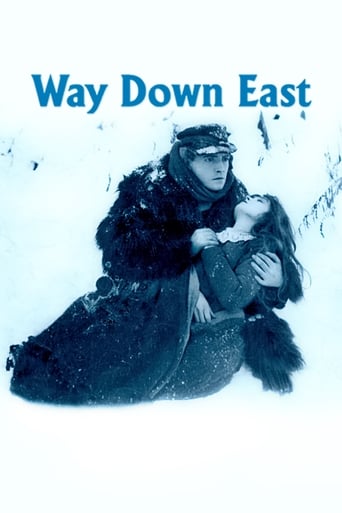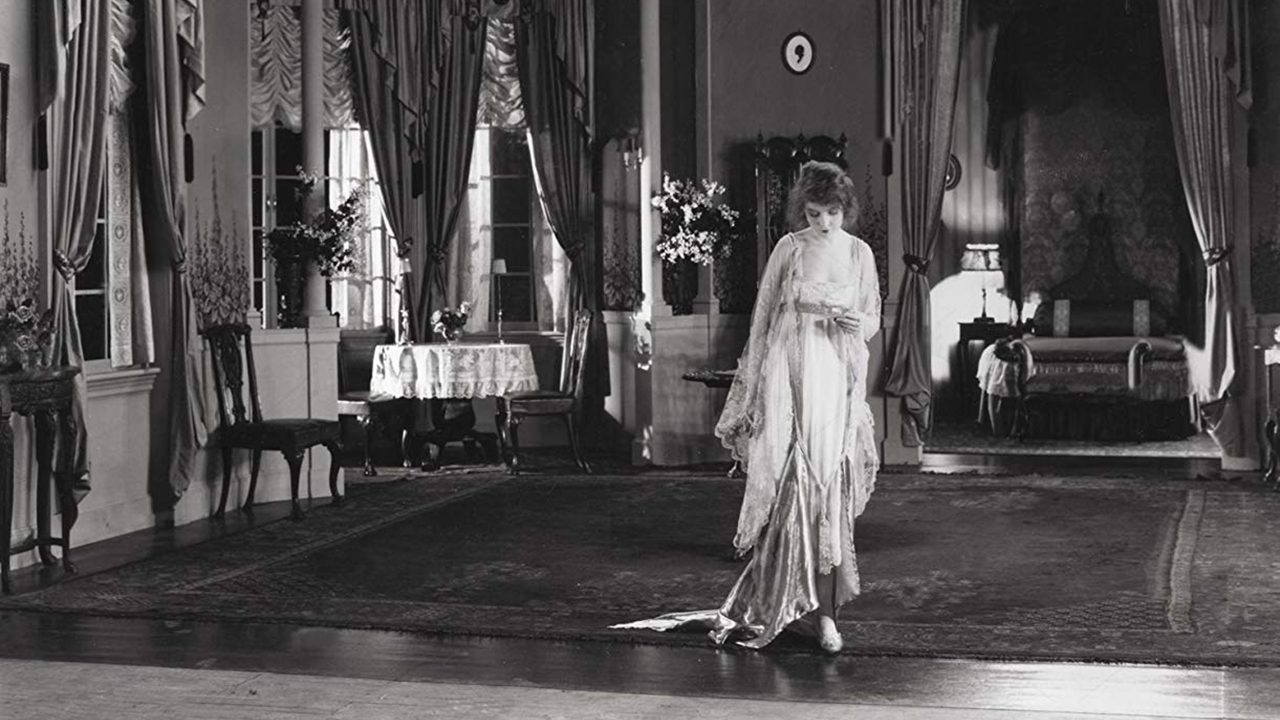Steffi_P
You can't keep a good story down. DW Griffith's film of Way Down East was an adaptation of a popular play of the late 19th century, but that play was itself a rather flagrant rip-off of the Robert Hardy novel Tess of the D'Urbervilles. True, the ending was substantially altered, and Way Down East's conclusions were fustily moralist compared with Hardy's bold progressiveness, but this in a way just goes to show how almost identical situations and characters can be adapted to suit a variety of means. Griffith keeps the moral sentiments of the play, but for this "elaboration" (the word used in the picture's publicity material at the time) he craftily sheers it of its staginess to produce a work of pure cinema.Technically Griffith may by now have been overtaken by his peers, but he has lost none of his ability to show character and intention through meaningful staging and encouragement of naturalistic acting. For example, when Lillian Gish turns up at her rich relatives' home, no title card reveals her sense of being out of her depth, but Griffith often keeps her in long shot, emphasising the isolating vastness of the house, and this has an impact on how we view the scene. We then realise Mrs Tremont's embarrassment at having this poor cousin walk into her life by the distance the woman keeps from Gish and her awkward attempts to avoid eye contact. One of the most nicely done scenes is the one of Gish's wedding to Lowell Sherman. Unconventionally, he keeps the camera behind the pastor, obscuring the couple, and keeping a cold empty space in the foreground. This really gives us the impression that something is not right here, even though we haven't been explicitly told so yet.What really impresses about Way Down East is its beauty, which suffuses almost every frame – exquisite countryside vistas, painterly shot compositions, not to mention many radiant close-ups of Ms Gish. Griffith always liked to make his pictures pleasing to the eye, but there is method in all this gorgeousness. Griffith uses natural beauty to emphasise the idyll of the Bartlett farm, and it's no coincidence that this is at its most striking in the shots when Gish first arrives there. And Griffith continually flatters Gish with the camera, framing her tenderly and often in soft focus, creating a visual metaphor for her delicacy and purity.Gish's acting is of top standard, far better than the hysterical hamming she displayed in the previous year's Broken Blossoms. It's also nice to see her in a proper adult role rather than the disturbingly odd little girl figure she was in that earlier picture. Richard Barthelmess is also excellent, and like Gish he is capable of expressing a lot by doing very little. Together Gish and Barthelmess give what are probably the best lead performances of any of Griffith's features. No-one else in this cast makes an exceptional impact, but none of them is outstandingly bad either.A fair few of those supporting players appear mainly for comic relief, and there are by Griffith's standards an unusually large number of comedic interludes in Way Down East. This unfortunately was one of Griffith's biggest weak spots. Some of these gags look like they might be fairly funny in themselves, but they don't look it because Griffith keeps hammering them home with close-ups, making them seem forced and predictable. He should have taken a leaf from his pal Chaplin's book, and shown a series of jokes in a continuous shot, giving them a more natural flow and getting more laughs as a result.Watching Way Down East also makes me wish Griffith the writer had more confidence in Griffith the director, as well as in his cast and his audience. This picture has far more intertitles than it really needs. There are several which reveal Lennox to be a bounder, but these are superfluous because there are enough clues in the way he scenes are staged and the way Lowell Sherman plays him. It would be far more satisfying for the audience if they were allowed to figure out for themselves that he is up to no good. Still, this is a comparatively small blight on what is one of DW Griffith's most visually lovely, deeply engaging and marvellously acted pictures.
didi-5
This film has a great reputation as one of the classics of the silent cinema - starring Lillian Gish as Anna, a simple soul from a poor family, but with rich relations; Richard Barthelmess as David, the son of a country Squire; and Lowell Sherman as Sanderson, an adventurer.Does it deserve its reputation? Well, Lillian Gish was certainly an excellent actress, very natural and expressive, and while the film drags a bit in places (and has some comedy scenes which really don't belong), it does have one or two places where the emotion of what's happening on screen reaches across the distance of nearly ninety years and makes the film work very well.Beautifully shot, especially the final scenes out on the river as the ice thaws, this is perhaps DW Griffith's best film - without the dubious racist leanings of Birth of a Nation or the OTT leanings of Intolerance. 'Way Down East', from a stage play, is an excellent film - yes, it is perhaps overly moralistic and more than a bit Victorian in its tone, but it still works well.
drednm
WAY DOWN EAST was an old-fashioned melodrama even in 1920 when D.W. Griffith decided to film it. It's the kind of story that leaves itself open for spoofing, but Griffith approaches the story of a "mock marriage" and its aftermath with earnestness and a great eye for detail.Aiding Griffith in bringing this story to life are three great stars: Lillian Gish as Anna, Richard Barthelmess as David, and Lowell Sherman as caddish Lennox. The supporting cast includes New England "types" that almost parody Dickens. Kate Bruce is the staunch mother, Creighton Hale the ditzy professor, Vivia Ogden the town gossip, Burr McIntosh the intolerant squire, Emily Fitzroy runs the hotel, etc.The story of love, betrayal, tolerance, and redemption is slow moving and has (as usual in a Griffith film) subplots, but like the very river, all the actions and events slowly come together for the finale that left 1920 audiences in a frenzy. Indeed the ending is among the most famous in all silent films.Gish is quite beautiful here. In her opening scene she is in her parlor with her mother making a broom, holding up the straw so that we see only her white cap and large expressive eyes. She's stunning. As Anna she goes through the gamut of shy maiden, young lover, wronged woman, timid servant, and town jezebel. Barthelmess is solid as the young and innocent David who falls in love with the servant girl.Their final scenes in the blizzard (filmed on Long Island in a real storm) on the icy river (filmed in White River Junction, VT) are totally amazing. And they did not use stunt doubles. As Gish lies exhausted on the piece of ice she may or may not know that it's heading for the falls. There are scenes were her hand and hair trail in the icy river. Just amazing. Barthelmess uses the breaking ice as a trail so that he can reach Gish before it's too late. There are several shots where he falls off the ice or the ice breaks under him and he plunges into that wintry river. The entire sequence is as thrilling today as it was in 1920.Gish once wrote that her long hair froze solid from being in the river water and snapped off with the ice.WAY DOWN EAST is a great film.
rdjeffers
Way Down East (1920)Friday January 26, 8:00pm, Kenyon HallIt was D. W. Griffith's second greatest success, but when he paid an outrageous sum ( double the budget of Birth of a Nation,1915) for the rights to Way Down East (1920), everyone thought he'd lost his mind. It was the stodgy old story of a naïve woman, betrayed by a man and rejected by a moralistic society. The film was so successful it paved the way for all of Griffith's subsequent films. Way Down East also represented a major change for Griffith and his movie 'family'.Cameraman G. W. 'Billy' Bitzer played a major part in Griffith's development. Already a seasoned cameraman when Griffith transformed himself from an actor into the greatest director of his day, Bitzer was his technical adviser, mentor and sounding board. By 1920, other cameramen had begun to ridicule Bitzer and his out of date Pathe newsreel camera. In his autobiography, Bitzer explained, " After me made Way Down East, my part in making Griffith films was that of just another cameraman." The Great director was known for discovering talent, but his head was easily turned, and the loyalty his crew and actors gave him was often a one sided affair. Griffith's favorite leading man had been Robert Herron almost from the beginning. The star of True Heart Susie (1919), Hearts of The World (1918), Intolerance (1916) and many others, had been cast aside in favor of a sophisticated new Griffith discovery, Richard Barthelmess. The night before Way Down East premiered in New York, Bobby Harron accidentally shot himself in his hotel room. He had purchased a pistol from a man in the street that was down on his luck and left it in his jacket pocket. As he took the jacket from his suitcase, the gun fell out and discharged when it hit the floor. Two days later, Bobby Herron was dead. He was twenty-six years old. Bitzer believed, " His death marked the end of an era. With Bobby's passing some thread of unity seemed to leave us." Regardless, Way Down East was magnificent. By 1920, Lillian Gish had become an actress of considerable depth and the story, with its harrowing climax has never entirely left the cultural consciousness of the American Cinema. Gish suffered permanent nerve damage in her hand after three weeks of rehearsal and filming on a frozen river where she insisted on submerging it in the icy water. By 1922, Gish was also shown the door.



 AD
AD



